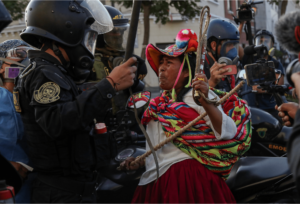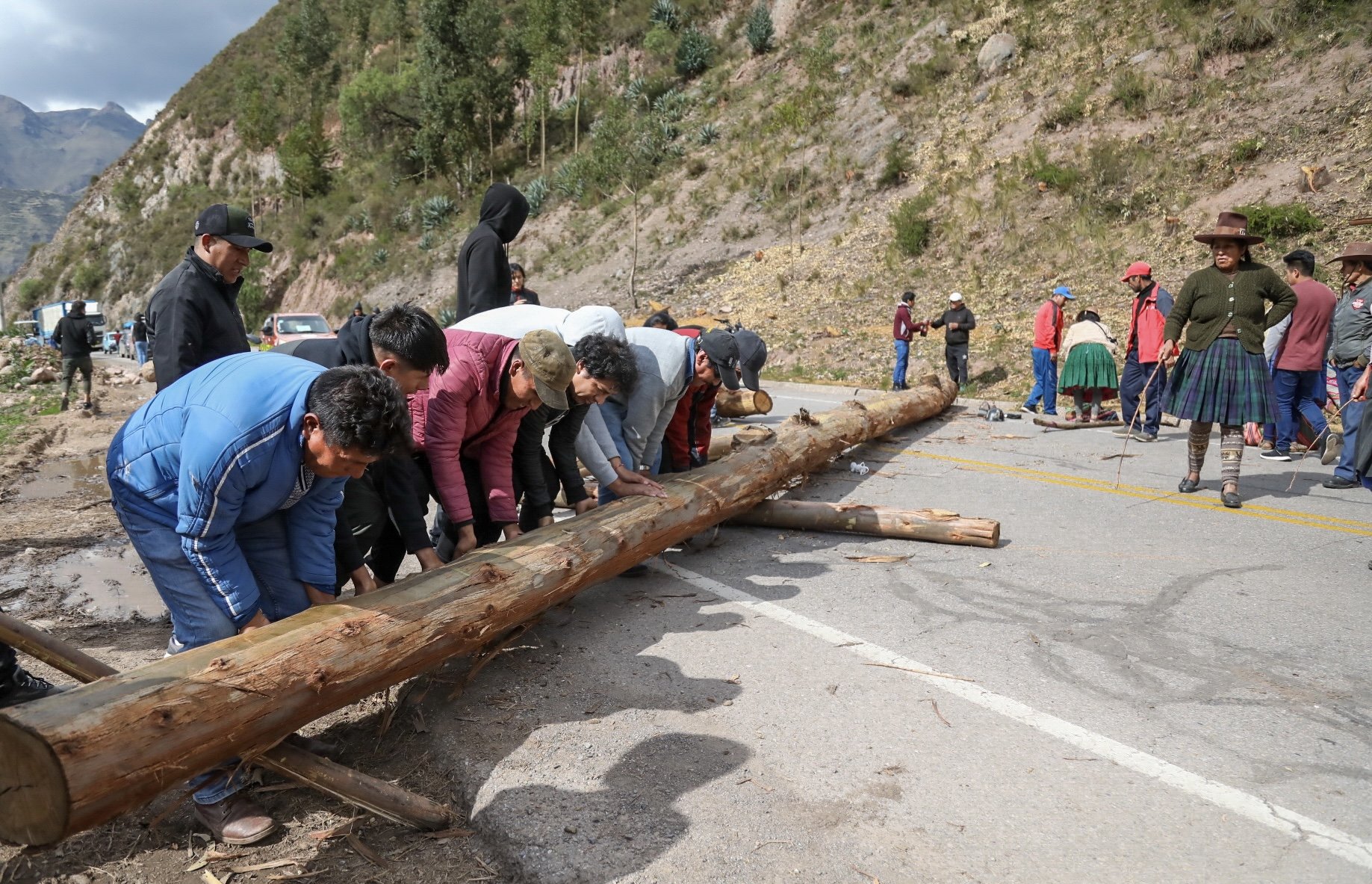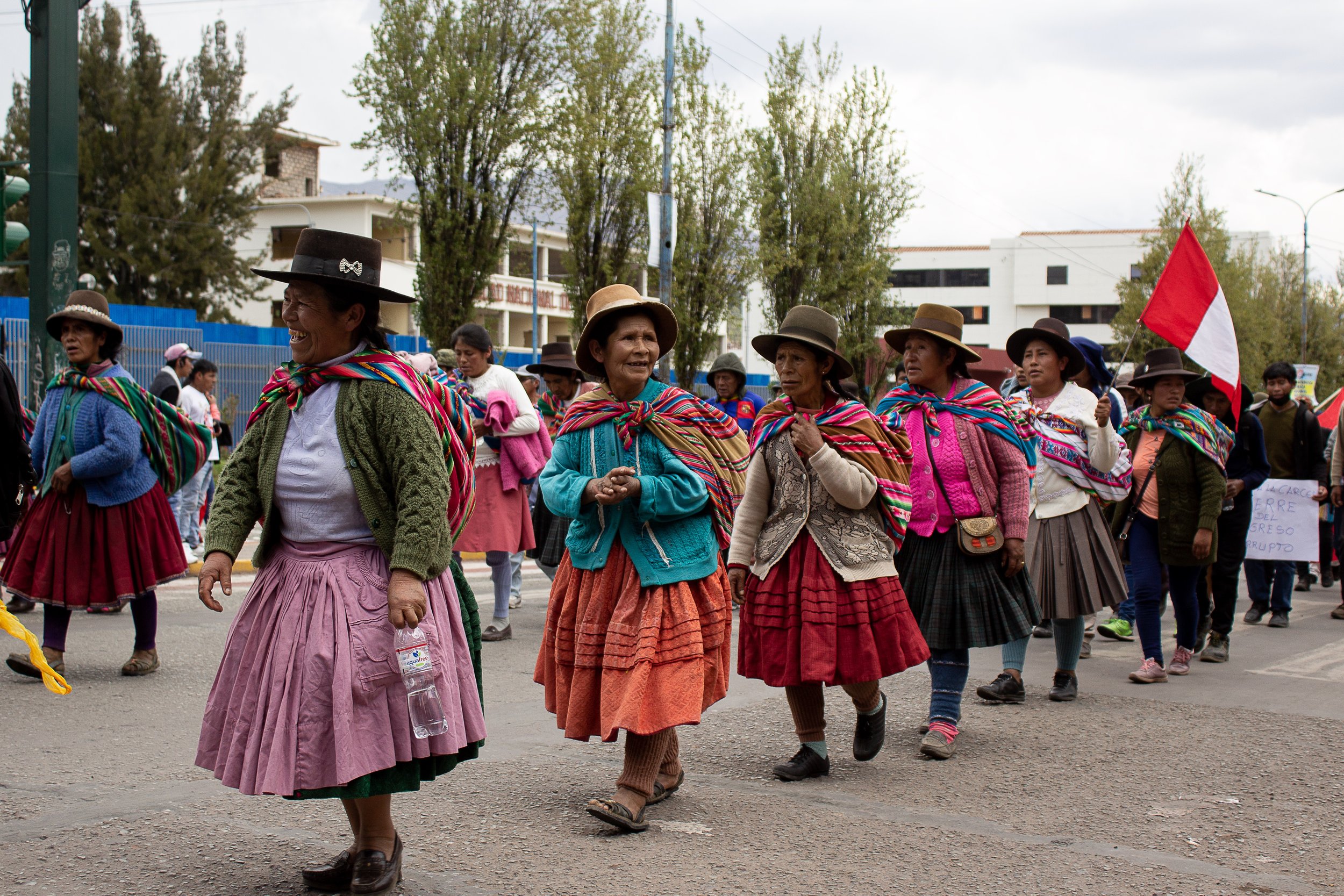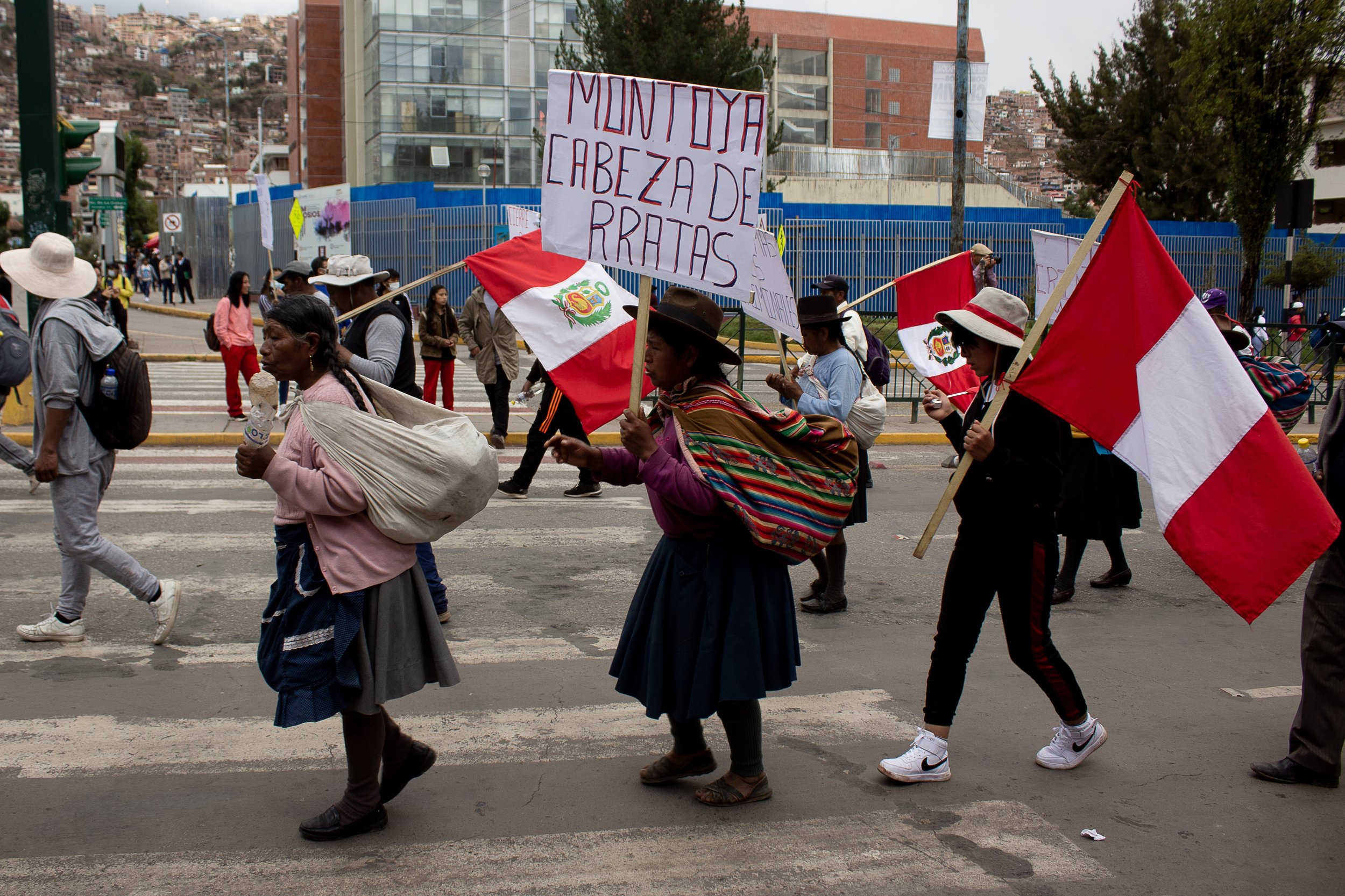
A woman from a delegation from Puno faces a police officer who previously repressed her with gas. Abancay Avenue, Lima, Peru, January 25 2023. Photo: Connie France.
An interview with Mirtha Vásquez, former PM under Pedro Castillo, on the explosion of unrest against the imposition of Dina Boluarte and the legacy of Fujimori.
Mirtha Vásquez is a lawyer representing communities struggling against extractivism in Cajamarca and the high Andes region of Peru. She’s a law professor and the ex-president of the Council of Ministers in the government of Pedro Castillo.
In this interview, carried out over Zoom in February of 2023, Vásquez shares a wide ranging interpretation of the complex and conflictive political panorama in Peru. She explains how constitutional reforms carried out during the Fujimorist period have been instrumentalized to repress communal organization. The communal systems of land ownership have been dismantled, making way for the economic conditions for extractivism as it exists in the country today.
Vásquez says the likes of the explosion of communal struggles such as that following the end of Castillo’s Presidency haven’t been seen in Peru since the 1960s, when Indigenous and small farmers mobilized to recover their lands. This uprising, she said, is a response to structural conditions and is itself a response to the lack of stability and the social crisis in the Peruvian state.
Gladys Tzul: We’ve seen images of hundreds of Indigenous communities who have protested in the context of the current political crisis. You’re a lawyer who has accompanied the struggles of these communities over the past years. How do you understand the current moment?
Mirta Vásquez: What we’re seeing right now is an explosion the likes of which we haven’t seen since the 1960s, when movements by campesino communities to recover lands emerged.
What’s happening today is similar. A movement has emerged from the most remote parts of the country. People are coming to Lima to say ‘we exist, we don’t want anymore exploitation, and we want to be considered citizens’ within a state which has always marginalized them and which has preserved serious inequalities.
We want Dina Boluarte to resign. She has aligned herself with the corporate right, with the land thieves, which continue to discriminate and spurn [the people], calling them ignorant and terrorists for daring to question the government politically.
They are demanding new elections, and the writing of a new constitution in which there are conditions for more equality and inclusion for them.
GT: I was hoping we could start from the epicenter of communal territorial struggles, and how those struggles are linked to this historic, national level uprising.
MV: Let’s start by saying that Perú is a country that maintains historic fissures determined by racism and classism. It’s a centralist country. That centralism has meant seeing the provinces as spaces which are meant to be exploited, and from where what is needed for a capitalist society can be extracted. That’s been the model for more than 200 years. We’ve seen that made clear over the last decades, and especially since the 1990s, when Fujimorism reigned.

People from Cusco block the highway in support of the National Strike on January 4, 2023. Photo: Connie France.
GT: Tell us more about the connection between Fujimorism and extractivism in Indigenous communities.
MV: [Alberto] Fujimori was an exceedingly populist president, and one of his strategies was to destroy or co-opt all social organizations. He introduced the notion that organizations are pointless and that the key relationship for the population should be with the executive [branch].
He built a system that appeared to arrive to the communities and take care of their needs. Through an alliance with the military, he imposed a regime based on violence. That’s what characterized the dictatorship of Fujimori.
In addition, using the argument that institutions like the Judiciary and the Attorney General’s Office needed restructuring, a new Constitution was introduced. That constitution opened the doors to neoliberalism.
GT: What characterizes that constitutional reform?
MV: I think there are three structural areas that help understand how Peru transited to a completely neoliberal model.
The first is the reform of the economic chapter, which says we are a social market economy, but which promotes the free market and indiscriminate private investment, with priority going to foreigners, even when their interests run against the rights of communities.
It includes benefits like the signing of legal contracts that encourage investors to come to our country, giving them as a benefit resource exploitation contracts that will not change over 30 to 50 years. The argument in favor of these contracts is that they provide stability for companies and incentivize investment.
Second are the legislative changes that removed all barriers for neoliberalism. For example, the form of property ownership of Indigenous and campesino communities was altered, and the prohibitions against buying, selling, renting or mortgaging communal lands were modified. That chapter stipulated communities could sell their territory if two thirds of the communities agreed. That was brought in under the General Law of Campesina Communities, Number 24656 (Article 7).
Finally, environmental law was modified and reduced to a single article, which says that everyone has the right to a healthy and adequate environment, and nothing more. The previous constitution made the state responsible for guaranteeing the protection and existence of such a fundamental right. The political system we have today brings this entire model into sharp relief.
During Fujimori’s government, processes were created that would modify existing norms and legislation so that they would become functional to the new economic model, so as to hand out contracts worth millions.
For example, at the Yanacocha mine, which is run by the largest gold company in Cajamarca, Vladimiro Montesinos corrupted judicial power to get a legal sentence in his favor, so that a particular company would end up with all of the shares, removing a French company from the area. [She’s referring to corruption on the part of the Peruvian government in favor of Newmont, operated by then presidential advisor Montesinos].
Presidents come and go, they govern using these structures, and base their governments on these laws. None of them have tried to change what Fujimori created. It’s against this whole corrupt neoliberal system, which generated increased inequality and impacts on Indigenous communities, on campesinos, and on society, and which relegated them, that people are rising up against today.

Women from the province of Canchis arrive to Cusco to march against the government of Dina Boluarte on January 10, 2023. To date, 61 people have been killed as the government represses protests. Photo: Elizabeth Florez.
GT: Fujimori created a populist clientelist wing and destroyed community organizations and social movements while also changing the regulations around communally owned rural land. Even so, 30 years on, it’s the communities that have sustained the current mobilization.
MV: Fujimorist politics was based on destroying organization, it criminalized political action. But it didn’t completely deactivate it. Even the Rondas campesinas [rural community defense organizations] outlived Fujimori.
Back then, the president said he was prepared to hand over weapons to create a civilian armed force of Fujimorismo, supposedly to defend against terrorism. The Rondas refused, though some smaller groups accepted and renamed themselves Self defense committees. But the Rondas resisted Fujimori, and said to him: “No, we refuse to become armed groups.” So Fujimorismo went after them as well.
It’s important to take that into account today, because in the current political crisis, the mobilization of Indigenous and campesino communities that are among the most abandoned has been historic. These communities have their own systems of subsistence and resistance, and carry on with life in a more or less autonomous way. Today they are actively defending their communities.
Since the 1990s almost all of the territories of campesino and Indigenous communities have been concessioned for forestry, mining, oil and gas.
Since 2000 we’ve seen an increase in social conflict in the high Andes region, and in the mountains, where the mining projects are located. The people have been in constant resistance, and the state has militarized many areas. Cajamarca was militarized, the state declared a regional emergency, it shot to kill, the repression was intense, people who exercised their right to protest were persecuted. It was similar in Apurímac and Arequipa.
It’s true that this took place in specific localities, in the communities we know the state will kill you if you resist. That was something people in the provinces already knew.
When Pedro Castillo ran for the presidency, people from the provinces voted for him thinking that he would try to undo this entire political and economic model.
But Castillo didn’t do anything about it, and I’m telling you that having been his Prime Minster. I told him: “President, it’s time to stop this, to create clear rules against the mining companies because they are affecting our relations with the communities.”
And he said no. That discouraged me from continuing in my role and after other issues, I resigned.
GT: Could you share your analysis of what is taking place now with Boluarte?
MV: Boluarte is a woman who is close to the extreme right, to the fascists, she governs with them and in alliance with the military sends [soldiers] to kill without thinking twice about people in the communities. First in Ayacucho and then in Puno. This has touched a very deep nerve among rural farmers and Indigenous people.
What we are seeing now is a political explosion, because the communities have come to Lima to demand Boluarte leave, because she represents the right that will continue to massacre them. They want the elections to happen sooner and for the violence, criminalization and persecution to end.

Women from the province of Quispicanchi arrive to Cusco to march against the government of Dina Boluarte on January 10, 2023. Photo: Elizabeth Florez.
GT: Do the miners govern the country? It’s foreign capital, but it needs a series of local connections and alliances with corporations. Are those the groups that are disputing the administration of the state?
MV: Yes, mining companies are hugely powerful in the country. Francisco Duran, a well known researcher who recently passed away, wrote a very well known book called La república empresarial (The Corporate Republic), the title is in reference to big corporations like the mining companies, which have consolidated their power over the last two administrations.
These companies are notorious for meddling in politics in Peru; in regulations, there have been moments when laws have been modified because there was deemed to be too much “red tape,” which is to say the administrative requirements that are asked of them in order to operate are, according to them, a barrier to investment; they have pushed for the lowering of environmental standards, and so on.
That’s why today, even within the right there are different positions. Some even want constitutional reforms, but of course, they are all in agreement that the economic chapter cannot be touched. Because yes, it’s the big companies, like the mining companies, that wish to continue to govern the country.
GT: Did Castillo’s government do enough?
MV: Historically members of campesino and Indigenous classes in Peru haven’t been considered, not even for a public sector job. They are classes that have only been thought about in terms of being governed, never in terms of governing. So the issue of identity, and especially the demand for a halt to the extractive industries meant Castillo received more votes than [Keiko] Fujimori and won the elections—but not by much.
In these circumstances, given the challenges Castillo faced, and knowing that he was the hope of thousands of Peruvians who have been forgotten, he decided to govern using the same corrupt structures, using the same structures that have always made the government into an opportunity for personal gain.
In that sense, it was also a kind of betrayal that he did not meet the minimum hopes and that his errors and his bad government created a scenario in which the extreme faction of the rightwing has taken over the government.
First published by Ojalá.


Leave a Reply